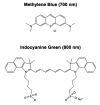Near infrared fluorescence for image-guided surgery
- PMID: 23256079
- PMCID: PMC3496513
- DOI: 10.3978/j.issn.2223-4292.2012.09.04
Near infrared fluorescence for image-guided surgery
Abstract
Near infrared (NIR) image-guided surgery holds great promise for improved surgical outcomes. A number of NIR image-guided surgical systems are currently in preclinical and clinical development with a few approved for limited clinical use. In order to wield the full power of NIR image-guided surgery, clinically available tissue and disease specific NIR fluorophores with high signal to background ratio are necessary. In the current review, the status of NIR image-guided surgery is discussed along with the desired chemical and biological properties of NIR fluorophores. Lastly, tissue and disease targeting strategies for NIR fluorophores are reviewed.
Keywords: Near infrared (NIR); image-guided surgery.
Figures



References
LinkOut - more resources
Full Text Sources
Other Literature Sources
Miscellaneous
